Geometrical Isomerism:
The isomerism which arises due to restricted (frozen) rotation about a bond in a molecule is known as geometrical or cis-trans isomerism. The rotation either about a double bond or about a single bond incorporated in a ring is restricted. Also, there may be restricted rotation about a single bond due to steric hindrance, e.g., as in biphenyls. Compounds having restricted rotation about a bond exhibit geometrical isomerism if they are suitable substituted.
Geometrical (eis-trans) isomerism is exhibited by a variety of compounds which may be classified as follows:
- Compounds containing a double bond C = C, C = N, N ≡ N.
- Compounds containing cyclic structure; homocyclic, heterocyclic and fused ring, ring systems.
- Compounds having restricted rotation about a single bond due to steric hindrance; some biphenyls,
No ostereoisomerism can result from triply bonded tetravalent or trivalent atoms because such systems display cylindrical symmetry.
CONDITIONS FOR GEOMETRICAL ISOMERISM
A compound will show geometrical isomerism if it fulfils the following two conditions:
- There should be restricted (frozen) rotation about a bond in the molecule.
- Both substitutents on each carbon about which rotation is frozen (restricted ) should be different.
Example
Alkenes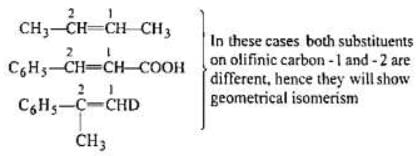
Cycloalkanes The above compounds will not show geometrical isomerism.
The above compounds will not show geometrical isomerism. The above compounds will show geometrical isomerism
The above compounds will show geometrical isomerism The above compounds will not show geometrical isomerism.
The above compounds will not show geometrical isomerism.
NOMENCLATURE
The compounds of the type abC = Cab can exist in the following two forms due to frozen rotation about carbon-carbon double bond.
This isomer in which similar groups are placed on the same side is called cis and the isomer in which the similar groups are on opposite sides is called trams.
Cis-trans nomenclature can be used only in those compounds in which type of substituents on both doubly carbons are two or three.
Example Cis-trans nomenclature cannot be used in those compounds where type of substituents resent on both doubly bonded carbons are four (or all four substitents are different).
Cis-trans nomenclature cannot be used in those compounds where type of substituents resent on both doubly bonded carbons are four (or all four substitents are different).
NUMBER OF GEOMETRICAL ISOMERS IN POLYNENS
Case -1: When two ends of chain are different Number of geometrical isomers = 2nd (where, n = number of double bonds)
Case -2: When two ends of chain are same
(a) n = even, number of geometrical isomers =
(b) n = odd, number of geometrical isomers =
E AND Z SYSTEM OF NOMENCLATURE
When four different atoms or groups are attached to the carbon atoms of a double bond, the E, Z system of nomenclature is used. The system is based on CIP rule. Example:
Example: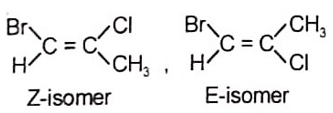



Rules for assigning:-
- Higher priority is assigned to the atoms of higher atomeic number.
Example: order of priority: 53I >35Br >17CI >9F >8O >1H - For isotopes, the isotope of higher mass number is given higher priority
Example: Order of priority:3T >2D >1H - In the groups, the order of priority is based on the higher atomic number of the first atom of the group.
Example: order of priority:
- When the order of priority of groups cannot be decided on the first atom than the second atom or the subsequent atoms in the groups are considered.
Example: order of priority:
- If an atoms is doubly or triply bonded to another atom, the priority system treats it as if it were singly bonded to those atoms.
Example: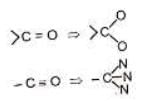
GEOMETRICAL ISOMERISM IN NITROGEN COMPOUNDS
Geometriacl isomerism due to >C = N- bond.
The important class of compounds exhibiting geometrical isomerism due to > C = N – bond are: (i) Oximes (ii) Nitrones (iii) Hydrazones and semicarbazones. But the most common compound is
oxime.
Oximes: In aldoxime, when hydrogen and hydroxyl groups are on the same side, the isomer is known as syn (analogous to cis) and when these groups are on the opposite sides, the isomer is known as anti (anglogous to trans) In ketoximes the prefixes syn and anti indicate as to which groups of ketoxime is syn or anti to hydroxyl group example:
In ketoximes the prefixes syn and anti indicate as to which groups of ketoxime is syn or anti to hydroxyl group example:
This compound will be named as:
(i) Syn-ethyl methyl ketoxime ⇒ HO and C2H5 are syn.
(ii) Anti-methyl ethyl ketoxime ⇒ HO and CH3 are anti.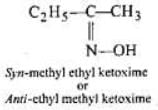
Geometrical isomerism in cycloalkanes: Disubstituted cycloalkanes show geometrical isomerism.
DEFINITION
Isomers which possess the same molecular and structural formula but differ in the arrangement of atoms or groups in space due to restricted rotation are known as geometrical isomers and the phenomenon is known as geometrical isomerism.
Conditions of geometrical Isomerism
(i) Geometrical isomerism arises due to the presence of a double bond or a ring structure
(i.e. ,- N = N - or ring structure).
,- N = N - or ring structure).
Due to the rigidity of double bond or the ring structure to rotate at the room temperature the molecules exist in two or more orientations. This rigidity to rotation is described as restricted rotation l hindered rotation l no rotation at each dou.
(ii) Different groups should be attached bly bonded atom.
For example: are identical but not geometrical isomers.
are identical but not geometrical isomers.
Example:
(A)
(Restricted Rotation)
(B)
(Restricted Rotation)
On the other hand, following types of compounds can exist as geometrical isomers :
Examples of Geometrical isomers:
(i) Along bond
bond and
and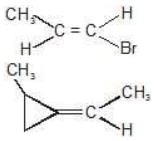 and
and
(ii) Along
 and
and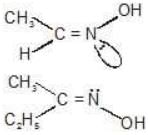 and
and and
and
 and
and
(iii) Along - N = N - bond and
and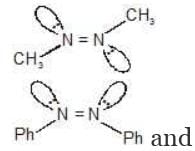

(iv) Along s bond of cycloalkane
 and
and
 and
and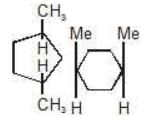 and
and
(v) Along in ring structures:
in ring structures:
Usually in cycloalkenes double bond has its configuration. Their trans isomers do not exist due to large angle strain. But if the ring is large enough a trans stereoisomer is also possible. The smallest trans cycloalkene that is stable enough to be isolated & stored is transcyclooctene.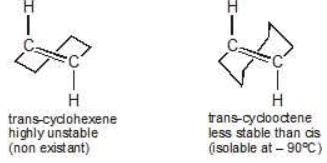
Configurational nomenclature in geometrical Isomerism:
| Configuration | Criteria | Remarks |
| cis / trans | Similarity of groups | If the two similar groups are on same side of restricted bond the configuration is cis otherwise trans. |
| E/Z | Seniority of groups | If the two senior groups are on same side of restricted bond the configuration is Z (Z = zusammen = together) otherwise E (E = entgegen = opposite). |
Sequence rules: (Cahn - Ingold - Prelog sequence rules) For deciding the seniority of groups, following rules are applied :
Ruel 1: The group with the first atom having higher atomic number is senior. According to this rule the seniority of atom is : I > Br > Cl > S > F > O > N > C > H
Rule 2: The higher mass isotope is senior.
Thus
(A) - T > - D > - H.
(B) - C14H3 > - C12H3
Rule 3: If the first atom of group is identical then second atom is observed for seniority. e.g.
(A) - CH2Cl > - CH2OH > - CH2NH2 > - CH2CH3 > - CH3
(B)
Rule 4: Groups containing double or triple bonds are assigned seniority as if both atoms were duplicated or triplicated that > C = Y as if it were & - C º Y as if it were
& - C º Y as if it were
e.g. for deciding seniority among - C º CH, - CH = CH2, their hypothetical equivalents are compared.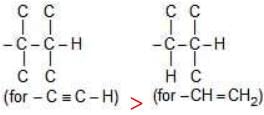
Rule 5: Bond pair gets priority over lone pair.
Rule 6: Z > E & R > S.
Number of Geometrical Isomers: Number of geometrical isomers can be found by calculating the number of stereocentres in the compound. (stereocentre is defined as an atom or bond bearing groups of such nature that an interchange of any two groups will produce a stereoisomer).
Physical Properties of Geometrical Isomers
| Physical properties |  | Remarks |
| Dipole moment | I > II | cis-isomer has resultant of dipoles while in trans isomer dipole moments cancel out. |
| Boiling point | I > II | Molecules having higher dipole moment have higher boiling point due to larger intermoleculer force of attraction. |
| Solubility (in H2O) | I > II | More polar molecules are more soluble in H2O. |
| Melting point | II > I | More symmetric isomers have higher melting points due to better packing in crystalline lattice & trans isomers are more symmetric than cis. |
| Stability | II > I | The molecule having more Vander Waals' strain are less stable. In cis isomer the bulky groups are closer they have larger vander Waals' strain. |
Table
| Physical properties |  |
| Dipole moment | I > II |
| Boiling point | I > II |
| Solubility (in H2O) | I > II |
| Melting point | I > II |
| Stability | I > II |
FAQs on Geometrical Isomerism - JEE
| 1. What is geometrical isomerism? |  |
| 2. How does geometrical isomerism occur? |  |
| 3. What are cis and trans isomers? |  |
| 4. How does geometrical isomerism affect the physical properties of a compound? |  |
| 5. Can geometrical isomerism occur in compounds other than alkenes and cyclic compounds? |  |



















